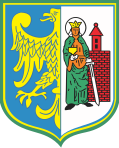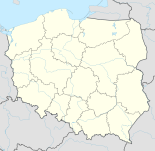Strumień
| Strumień | ||
|---|---|---|

|
|
|
| Basic data | ||
| State : | Poland | |
| Voivodeship : | Silesia | |
| Powiat : | Cieszyn | |
| Area : | 6.31 km² | |
| Geographic location : | 49 ° 56 ' N , 18 ° 46' E | |
| Residents : | 3718 (June 30, 2019) |
|
| Postal code : | 43-246 | |
| Telephone code : | (+48) 33 | |
| License plate : | SCI | |
| Economy and Transport | ||
| Street : | Droga krajowa 81 | |
| Droga wojewódzka 939 | ||
| Next international airport : | Katowice | |
| Gmina | ||
| Gminatype: | Urban and rural municipality | |
| Gmina structure: | 6 localities | |
| 5 school offices | ||
| Surface: | 58.40 km² | |
| Residents: | 13,240 (June 30, 2019) |
|
| Population density : | 227 inhabitants / km² | |
| Community number ( GUS ): | 2403113 | |
| Administration (as of 2016) | ||
| Mayoress : | Anna Grygierek | |
| Address: | Rynek 4 43-246 Strumień |
|
| Website : | www.strumien.pl | |
Strumień [ ˈstrumʲɛɲ ] ( German Schwarzwasser , Czech Strumeň ) is a city in the powiat Cieszyński of the Polish Silesian Voivodeship . The city, with over 3,000 inhabitants, is the capital of an urban and rural community with around 12,000 inhabitants.
geography
The Strumień municipality is located in the north of the historical region of Cieszyn Silesia on the border with Upper Silesia . In addition, the city is located in the southeast of the Silesian Voivodeship about 20 km northwest of Bielsko-Biała (German Bielitz-Biala ) and about 12 km from the city center of Jastrzębie Zdrój (German Bad Königsdorff-Jastrzemb ). The Vistula flows through the municipality , which has been dammed by the Goczałkowice reservoir since 1955 , to which the municipality borders.
history
The brook Czarny Strumień / Schwarzwasser was first mentioned in 1293 and the village Swarczenwassir was first mentioned in 1407. It was closely connected with the Plessian region and belonged to the parish in Wisła Mała in the Krakow diocese (a branch church was not mentioned until 1454). With the increasing splintering of the rulers of Silesia , the place fell to the Duchy of Ratibor towards the end of the 13th century , with which it came under the crown of Bohemia in 1327 . At the beginning of the 15th century it came to the rule of Pless . As a result, Schwarzwasser changed hands frequently until it finally became part of the Duchy of Teschen around 1480 . The Teschen Duke Casimir II later handed the village over to his Marshal Nikolaus Brodecki. Under his rule until 1518, the place experienced a rapid boom with the rise of fish farming and the flourishing of handicrafts . The location at the crossroads of trade routes from Moravia to Krakow and from Racibórz to Bielsko was also beneficial . This development is also reflected in the granting of city rights to Schwarzwasser in 1482 as well as other privileges in the following years. In addition , weekly and annual markets were held in the new town, mostly known under the Polish name Strumień . Probably at that time the local parish was separated from the Krakow diocese and placed under the Wroclaw diocese. After King Vladislav II had confirmed the town charter in 1503, the town was given the privilege of having its own coat of arms and seal . Even then, the coat of arms showed the image of St. Barbara . Soon afterwards, large parts of Schwarzwasser fell victim to a conflagration in 1572, after which the city was rebuilt in 30 years. In the years 1573 and 1577 to approx. 1594 there was a short-term rulership Skotschau- Schwarzwasser. The Thirty Years' War and another city fire in 1688 caused further destruction. In that year the German name returned as Schwarzwasser vulgo [usually] Strumien and the city was then called with the double name. In 1742 Schwarzwasser did not become Prussian like most of Silesia , but became a border town in Austrian Silesia . The city was frequently ravaged by epidemics and floods, and another fire in 1793 destroyed 73 buildings, including the town hall. During the subsequent reconstruction, mostly stone houses were built.
With the opening of the first textile factories in nearby Bielitz at the beginning of the 19th century, the local draperies, who had become important since the 17th century, were faced with an insurmountable competition problem and the overall economy of Schwarzwasser also experienced a decline.
Because initial resistance of the population that could until 1911 (the same year in favor of the township licensed) six kilometers narrow gauge local train to chybí be built, with the opening on February 10, 1911 Black water on the track chybí - Pawlowitz joined. This compensated for the city's unfavorable location in terms of traffic and allowed a certain upswing again. At that time, a tile and a sawmill were built . After the re-establishment of the Polish state in 1918, Schwarzwasser became part of Poland under its Polish name Strumień , even if the city tour, which was shaped by Germans (mostly local Slavic origin) and so-called Schlonsaken , advocated affiliation with the German Empire . During the Third Polish Uprising in Prussian Upper Silesia in 1921, there was a leadership staff of the rebels in Strumień, which is close to the border.
In the interwar period , Strumień was one of the poorest cities in the Silesian Autonomous Voivodeship . In the 1930s, pottery production in Strumień gained importance with a ceramics factory and, since 1938, a technical school. During the attack on Poland at the beginning of World War II , the city was occupied by the Wehrmacht in 1939 and, contrary to international law, allocated to the new district of Bielitz . Towards the end of the war, heavy fighting between the Red Army and the Wehrmacht took place in the vicinity of the city . 60% of Strumień was destroyed during these battles and finally during the capture of the city.
Population development
| year | 1619 | 1790 | 1880 | 1890 | 1900 | 1910 | 1921 | 1939 | 1984 | 1998 | 2004 |
|---|---|---|---|---|---|---|---|---|---|---|---|
| Residents | 660 | 1,130 | 1,669 | 1,590 | 1,411 | 1,513 | 1,566 | 2,100 | 2,600 | 3,400 | 3,445 |
- ↑ Including: 1396 (83.6%) Polish-speaking, 257 (15.4%) German-speaking, 16 (1%) Czech-speaking;
- ↑ Including: 1231 (77.4%) Polish-speaking, 347 (21.8%) German-speaking, 12 (0.8%) Czech-speaking;
- ↑ Including: 905 (64.2%) Polish-speaking, 407 (35.2%) German-speaking, 9 (0.6%) Polish-speaking; 1431 (95.1%) Roman Catholic, 20 (1.3%) Protestant, 54 (3.6%) Israelite;
- ↑ Including: 681 (45%) Polish-speaking, 824 (54.5%) German-speaking, 8 (0.5%) Czech-speaking; 1484 (94%) Roman Catholic, 28 (1.8%) Protestant, 67 (4.2%) Israelite;
- ↑ Including: 1472 Poles, 59 Germans, 31 Jews; 1474 Roman Catholic, 35 Protestant, 56 Israelite;
Attractions
The town hall from 1628 is on the right-hand side of the ring. Today's late Baroque building and above all the clock tower crowned with an onion dome in the middle of the facade were built after the town fire of 1793. The building was expanded in the 19th century, including additional floors.
The ring is framed by town houses, some of which can still be assigned to the Baroque or Rococo, but most were redesigned in the 19th century. A Marian column was erected in the middle of the ring in 1886.
The current baroque construction of the parish church of St. Barbara began in 1789, the front tower was erected in 1792 and the structure was completed in 1793. At that time, three bells from the previous church that had broken off were hung in the tower, of which only the smallest from 1766 has survived. The interior of the church, which was renovated in 1936, still has a rococo pulpit and paintings from the 17th and 18th centuries and was painted in 1965.
The local estate consists of a manor house from the 18th century and commercial and residential buildings from the 19th century.
Town twinning
- Petřvald , Czech Republic (2002)
local community
In addition to the city of Strumień, the urban and rural municipality of Strumień is divided into the following districts (as of December 31, 2006):
- Bąków (Bonkau) ; 1,470
- Drogomyśl (Drahomischl) ; 2.110
- Pruchna ; 2,442
- Zabłocie (Zablatsch) ; 1,320
- Zbytków (Zbitkau) ; 1,239
The municipality belongs to the Śląsk Cieszyński Euroregion .
literature
Lech Szaraniec: Zabytkowe ośrodki miejskie; Górny Śląsk i Małopolska. Muzeum Śląskie, Kattowitz 1996, ISBN 83-85039-52-X (Polish book about historical city facilities in Upper Silesia and Lesser Poland; including Strumień)
Web links
- Official website of the city
- Strumień on a website about the territory of the former Duchy of Teschen (Polish)
- City portal
Individual evidence
- ↑ a b population. Size and Structure by Territorial Division. As of June 30, 2019. Główny Urząd Statystyczny (GUS) (PDF files; 0.99 MiB), accessed December 24, 2019 .
- ^ Idzi Panic: Śląsk Cieszyński w średniowieczu (do 1528) . Starostwo Powiatowe w Cieszynie, Cieszyn 2010, ISBN 978-83-926929-3-5 , p. 306 (Polish).
- ↑ Robert Mrózek: nazwy miejscowe dawnego Śląska Cieszyńskiego . Uniwersytet Śląski w Katowicach , 1984, ISSN 0208-6336 , p. 166 (Polish).
- ↑ Wojciech Kiełkowski: Chybie - dzieje gminy od czasów najdawniejszych do współczesności . Chybie 2009, ISBN 978-83-910611-5-2 , pp. 39 .
- ↑ See also [1]
- ↑ See archived copy ( memento of the original from April 19, 2006 in the Internet Archive ) Info: The archive link has been inserted automatically and has not yet been checked. Please check the original and archive link according to the instructions and then remove this notice.
- ^ Certificate of concession for the local railway from Chybi to Schwarzwasser. In: Reichsgesetzblatt for the kingdoms and states represented in the Reichsrathe , year 1911, RGBl. 1911/35, pp. 121-125. (Online at ANNO ). .
- ↑ Building a bridge over the Vistula near Schwarzwasser. In: The Interesting Sheet , No. 11/1911 (XXX. Year), March 16, 1911, p. 7, center right. (Online at ANNO ). .
- ↑ Construction news. (...) Bohemia. (...) black water. In: Der Bautechniker , No. 10/1911 (XXXI. Year), March 10, 1911, p. 212, center left. (Online at ANNO ). .
- ↑ a b cf. Zabytkowe ośrodki miejskie; Górny Śląsk i Małopolska
- ↑ a b c d Kazimierz Piątkowski: Stosunki narodowościowe w Księstwie Cieszyńskiem . Macierz Szkolna Księstwa Cieszyńskiego, Cieszyn 1918, p. 262, 280 (Polish, opole.pl ).
- ↑ Ludwig Patryn (ed.): The results of the census of December 31, 1910 in Silesia. Troppau 1912.
- ↑ Główny Urząd Statystyczny: Skorowidz miejscowości Rzeczypospolitej Polskiej. Województwo krakowskie i Śląsk Cieszyński . Warszawa 1925, p. 68 (Polish, Woj.krakowskie i Sląsk Cieszynski miejscowości.pdf ).
- ^ Encyclopedia Powszechna PWN
- ↑ [2]
- ↑ PDF ( page no longer available , search in web archives ) Info: The link was automatically marked as defective. Please check the link according to the instructions and then remove this notice.
- ↑ See http://www.strumien.pl/documents/default.php?class_id=3&doc_id=0&layout=0




